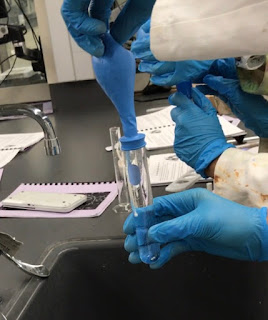Lab 1: Density Block Lab
Density Block Lab
Ben Fredeen
Ben Fredeen
Introduction:
The purpose of this lab to calculate the mass of of a block using its given density and volume. This will be done by using the given density and finding the volume and then finding the percent
of error to make sure all procedures and calculations were done correctly. The important terms for this include volume, density, mass and significant digits. Volume is the amount of space an object takes up or the mass divided by density. Density is the how compact and object is or the mass divided by volume. Mass is the amount of matter in an object or the volume times density. Significant digits are all of the digit read plus one estimated digit when measuring.
Procedure:
To begin the lab, a block with a given density, 2.7g/cm3, was received. The dimensions of the block were measured using a 30 centimeter ruler, with marked millimeters, to calculate the volume. When measuring we made sure that our estimates had only one estimated digit after the certain digits. The side length on the cube block was 2.50 cm which means that volume was 2.50cm cubed which equaled 15.625cm3. Then, to find the mass, the volume was multiplied by the density which was 15.625cm3 times 2.7g/cm3 which equaled 42.1875g. This was changed to match the correct number of significant digits and since there were only three because 2.50cm only has three, 42.1875g was changed to 42.2g. To make sure all procedures were done correctly, the percent of error was calculated by using the equation %error= [(actual-experimental)/actual] x 100%. The actual mass was 44g so when plugged into the equation, [(44g-42.2g)/44g] x 100%, the percent error was about 4.09% off.
First, the volume of the cube block was calculated by using the measurement 2.50cm cubed which equaled 15.625cm3. This was multiplied by the density which was 2.7g/cm3 which equaled 42.2g when following the correct significant digit rules. Then, we tested the accuracy by finding the percent error. The actual mass was 44g so after plugging it into the equation the percent error was 4.09% off so it was within a reasonable range of the actual mass.
Conclusion:
Overall, the lab was a success. After the first attempt, it was within a 5% error so it went well. We were able to calculate the mass using the density and finding the volume. The only real areas for error were the initial measure on the dimensions of the block or an error in the calculations. What I learned from the lab was that the mass is able to easily calculated by using its density and volume but the measurements should be accurate or else the results can be inaccurate.
of error to make sure all procedures and calculations were done correctly. The important terms for this include volume, density, mass and significant digits. Volume is the amount of space an object takes up or the mass divided by density. Density is the how compact and object is or the mass divided by volume. Mass is the amount of matter in an object or the volume times density. Significant digits are all of the digit read plus one estimated digit when measuring.
Procedure:
To begin the lab, a block with a given density, 2.7g/cm3, was received. The dimensions of the block were measured using a 30 centimeter ruler, with marked millimeters, to calculate the volume. When measuring we made sure that our estimates had only one estimated digit after the certain digits. The side length on the cube block was 2.50 cm which means that volume was 2.50cm cubed which equaled 15.625cm3. Then, to find the mass, the volume was multiplied by the density which was 15.625cm3 times 2.7g/cm3 which equaled 42.1875g. This was changed to match the correct number of significant digits and since there were only three because 2.50cm only has three, 42.1875g was changed to 42.2g. To make sure all procedures were done correctly, the percent of error was calculated by using the equation %error= [(actual-experimental)/actual] x 100%. The actual mass was 44g so when plugged into the equation, [(44g-42.2g)/44g] x 100%, the percent error was about 4.09% off.
Data:
Conclusion:
Overall, the lab was a success. After the first attempt, it was within a 5% error so it went well. We were able to calculate the mass using the density and finding the volume. The only real areas for error were the initial measure on the dimensions of the block or an error in the calculations. What I learned from the lab was that the mass is able to easily calculated by using its density and volume but the measurements should be accurate or else the results can be inaccurate.






Comments
Post a Comment